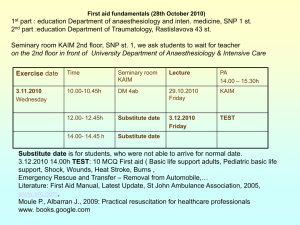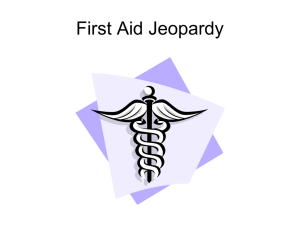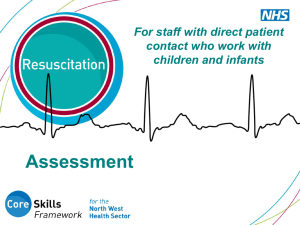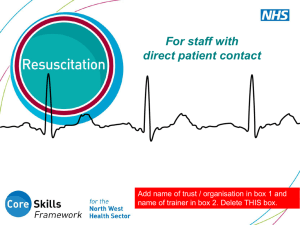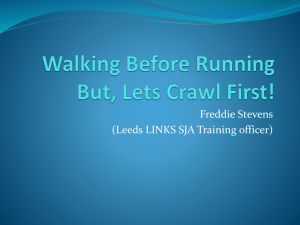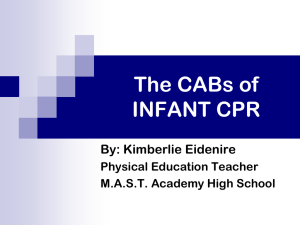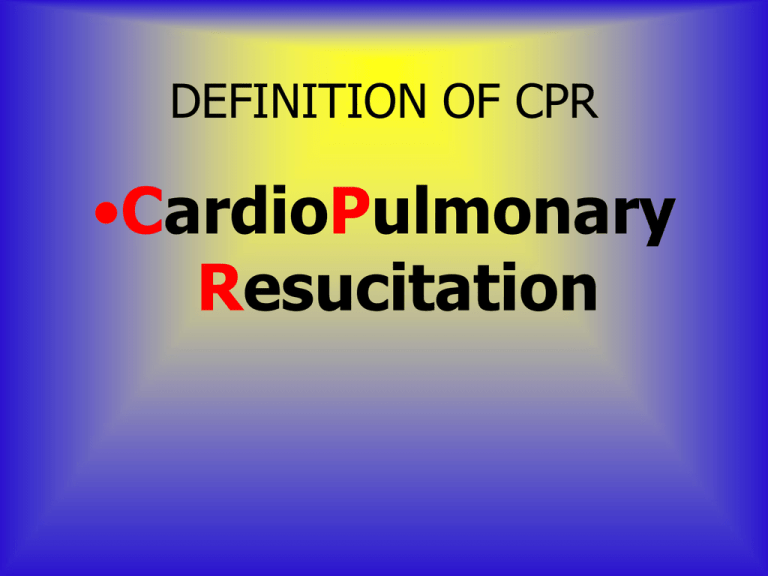
DEFINITION OF CPR
•CardioPulmonary
Resucitation
Heart disease
• Heart disease is the number one
killer in the United States today,
and over 60% of all victims will die
before they reach the hospital!
• The heart lies between the
sternum and the spine.
What are the functions of CPR?
A. As basic life support – to maintain a viable (living) victim for
advanced life support. (EMS)
– EMS stands for Emergency Medical Service
B. To minimize the occurrence of panic during times of
emergency.
C. For early diagnosis and detection of the symptoms of heart
attack.
– Be able to recognize the signs of a heart attack.
– The greatest risk of death from heart attack is in the
initial two hours after the onset of the symptoms
– 60% of all victims die before they reach the hospital.
(paramedics now stabilize the victim at the site before
transporting.)
What does CPR stand for?
• C = Cardio (heart)
• P = Pulmonary (lungs)
• R = Resuscitation (recover)
Oxygen is the basic requirement for breathing and every
Living cell in the body
The function of the epiglottis is to guard the entrance to
trachea
What types of situations might
cause a victim to need CPR?
•
•
•
•
•
•
Heart attack
Electrocution
Drug overdose
Accidents
Stroke
Diabetes
•
•
•
•
•
•
Choking
Poisoning
Smoke Inhalation
Epilepsy
Suffocation
Drowning
Emergency Situations Requiring
CPR and Emergency First Aid
Alcohol Overdose - Alcohol Poisoning
Drug or Medicine Overdose
Choking – Airway Obstruction
Auto Accident
Electrical Shock
Gun Shot
Stabbing/Knife Wound
Smoke Inhalation
Drowning
Poisoning
Heat Exhaustion
Over Exposure to
Cold Temperatures
What are the real symptoms
of a heart attack?
• Uncomfortable pressure and squeezing, usually
located in the center of the chest
• Pain may spread to shoulders, arms, neck, and
back (usually on the left side)
• The pain is not always severe and may come and
go (sharp, stabbing twinges of pain usually are
not signals of heart attack)
• Sweating, nausea, shortness of breath, feeling of
weakness
– May occur in either sex, even young adults,
and not necessarily during physical or
emotional stress.
How does the heart work?
• The right side of the heart receives
deoxygenated blood from the body
which it then pump to the lungs
(through the pulmonary artery) where
carbon dioxide is exchanged for oxygen.
• The left side of the heart receives the
oxygenated blood from the lungs
(through the pulmonary vein) which it
then pumps through the atrium to the
ventricle; from the ventricle the blood is
pumped through the aorta to the rest of
the body.
How to help a heart attack victim
that is conscious
• Help the victim into a comfortable
position
– Sitting if he or she is short of breath
– Lying down if he or she is light headed
• Loosen clothing around neck and
waist.
• Call an ambulance. Call 911!
http://www.pbs.org/wgbh/nova/heart/troubled.html
Definitions
• Coronary Heart Disease – the blood supply to
a part of the heart is blocked; that part of the
heart not receiving oxygen begins to die.
• Respiratory Arrest – breathing stops
• Cardiac Arrest – the heart has stopped
• Stroke – the blood supply to a part of the brain
is blocked; those brain cells not receiving
oxygen begin to die.
• Clinical Death – means the heart and
breathing have stopped.
• Heart attack – A sudden severe instance of
abnormal heart function.
Definitions Continued…
Brain Death – Occurs 4-6 minutes after
clinical death when the cells of the brain
begin to die.
Biological death- all systems cease to
function. Organ systems have shut down
and are no longer working
General CPR; In Three
Simple Steps: ABC
1. Airway – head tilt, chin lift
2. Breathing – look, listen, feel
3. Circulation – give chest
compressions
Adult; over 8 years old; CPR
check for unresponsiveness
and call for help
A. Check the Victim for unresponsiveness.
Gently shake them and ask “Are you all right,
are you okay?”
B. If the victim doesn’t respond SEND SOMEONE
TO GET HELP. Call 911 and return to the victim.
Adult CPR
Airway and breathing
C. Use the head tilt, chin lift
method to open airway. Look,
listen and feel for breathing.
D. If the victim is not breathing
normally, pinch the nose and
cover their mouth with yours.
Give 2 full breaths until you see
the chest rise. Each breath should
last about 1 second.
E. With each breath the chest
should lower and rise so you
know that air is getting in.
Adult CPR
F. After giving two breaths,
immediately begin chest
compressions.
G. Use the nipple line (“armpit over”)
to determine the proper place to do
chest compressions.
H. Push down on the chest 1 1/2 to 2
inches, 30 times right between the
nipples where the heart lies. (ratio
30:2)
J. Pump at the rate of 100
compressions / 1 minute
K. If you see chest movement, put the
victim in the side position in case
they vomit.
Chest compressions should be performed on the lower
½ of the sternum
For each compression it is important to push down
far enough and to be sure the chest is completely
released after each compression. This will allow
the heart to fill with blood after each compression.
Recovery
Position
What is the
Recovery Position?
•First Aid procedure to use if
the person is unconscious,
breathing and have a pulse.
•It is a safe position to put
them in while you are waiting
for the EMS to arrive
•Allows them to breathe easily
and prevents them from
choking on their tongue or
any vomit.
CPR: Children
1 to 8 years of age
A. Check for unresponsiveness
B. If you are alone with the child give 4-5 cycles of 30
compressions before calling 911.
C. Open the airway
D. Check for breathing: look, listen, feel
E. Not breathing: give 2 breaths
F. Perform chest compressions on the nipple line in
the center of the chest.
G. If the child is small, use one hand for
compressions. If the child is larger, use 2 hands.
H. Press the sternum down 1” to 1 ½”.
I. Give 30 compressions to 2 breaths (ratio of 30:2).
J. Pump at the rate of 100 compressions per 1 minute
K. You should perform 5 cycles of 30 compressions in
2 minutes.
CPR: Infant; 0 to 1 year
check for unresponsiveness;
call for help
A. Check for
unresponsiveness:
tickle, touch, pinch
the infant gently.
B. If there is no
response, perform 5
cycles of 30
compressions before
calling 911.
CPR: Infant; open airway
C. A = Open The Airway.
D. Tilt the head back gently, only far
enough so that the infant’s mouth
is facing the ceiling. Do not tilt
the head too far back! This may
injure the neck, and collapse the
airway.
CPR: INFANT; check breathing
E. B = breathing: Look, listen, and feel for
air.
F. If the infant is NOT breathing give 2
small gentle “puffs” of air.
G. Cover both the baby's mouth AND nose
with your mouth.
H. You should see the baby's chest rise
with each breath.
CPR: Infants; check circulation
I. The proper placement for chest
compressions is just below the
nipple line.
J. Position your 3rd and 4th fingers in
the center of the chest ½ inch
below the nipples.
K. Press down ½” to 1”.
L. Perform 30 chest compressions at a
ratio of 30:2 (30 compressions for
every 2 breaths)
M. At least 100 compressions should
be given within 1 minute.
CPR: Infants
If the infant recovers, put them in
the recovery position by gently
supporting the neck and picking
them up.
Under what special circumstances
can a non-physician discontinue
CPR?
•
•
•
•
The victim responds.
The rescuer collapses.
A doctor pronounces the victim dead.
Someone with equal or more training
takes over.
• With a child/infant – stop after 1
minute to call 911 if you alone, and no
one will be coming.
Obstructed airway (choking)
• Partially obstructed airway with good air
exchange: victim can make some sounds; may
be able to speak and cough
• Partially obstructed airway with poor
exchange: victim cannot speak, may be
wheezing or coughing weakly
• Fully obstructed airway: victim cannot make
any sounds
• The most common cause of an airway
obstruction in a conscious person is food or a
foreign object.
• The most common cause of an airway
obstruction in an unconscious person is the
tongue.
Adult choking; conscious
The Heimlich maneuver
A. Ask the victim: : “Are you choking?”
B. If the victim nods yes, ask them “Would you like
my help?”
•
If they say “NO”, do not help them. If they say
yes, you may help them.
C. Position yourself by placing one of your legs
between the legs of your victim. Give 5
abdominal thrusts and continue as needed.
–
For a pregnant or obese person, perform chest thrusts.
D. Repeat thrusts until the object is expelled and the
obstruction is relieved OR the victim becomes
unresponsive/unconscious.
CONSCIOUS ADULT CHOKING
Adult choking; unconscious
A. Call 911.
B. Open the airway.
C. Perform a finger sweep to remove possible
foreign object in mouth.
D. Open the airway and try to get air in. Give 2
breaths. If air does not go in, reposition the
head and give 2 more breaths. If air still does
not go in, the airway is obstructed.
F. With the victim lying on the floor, give 5
abdominal thrusts while straddling your
victim.
G. Repeat the steps until victim is no longer
choking or continue the steps of CPR as
needed.
ADULT UNCONSCIOUS CHOKING
You would straddle the victim while
performing any needed CPR and abdominal chest thrusts
Do not push down on the Xiphoid process!
Infant choking; conscious
A. Check for breathing difficulty, ineffective
cough, weak cry.
B. Confirm signs of severe or complete airway
obstruction.
C. Give 5 back blows with your open hand and 5
chest thrusts, using your 3rd and 4th fingers.
D. Repeat back blows and chest thrusts until
object is expelled OR the victim becomes
unresponsive.
BACK SLAPS
FINGER SWEEP
CHEST THRUSTS
Infant choking; unconscious
A. Call 911
B. Open the airway and if you see the object, remove it
C. Try to give 2 breaths. If the chest does not rise, reopen the airway and try to give 2 more breaths.
D. If the air still does not go in they are choking. Give 5
back blows, 5 chest thrusts and 2 breaths. Re-open
airway and give 2 more breaths.
E. Repeat above steps until breathing is effective.
Perform CPR if needed.
F. If the rescuer is alone and the airway obstruction is
not relieved after 1 minute, call 911.
Treat a conscious or unconscious child (1-8 years
old) with an airway obstruction like a conscious or
unconscious adult with an airway obstruction.
Example of a conscious choking child
• When performing CPR, the victim must
be placed on a firm, flat surface, in the
“head-tilt, chin-lift” position
• The universal sign for choking is two
hands placed at the throat
• If you give a victim 2 full breaths and
they don’t seem to go in, you should retilt the head (head tilt, chin lift) and try
again. If the air still does not go in your
victim may be choking..
• In a two person rescue situation,
rescuers should rotate between
compressions and breathing every
2 minutes to avoid fatigue.
• Ideally, the rescuers should switch
positions within 5 seconds so the
victim is not left unattended for
too long.
Good Samaritan Law
Law that protects rescuers from prosecution or civil
law suits, unless their actions constitute willful
misconduct and negligence.
The Rescuer MUST comply with proper
emergency first aid and CPR guidelines; acting in
good faith by being prudent and responsible in their
rescue efforts.


